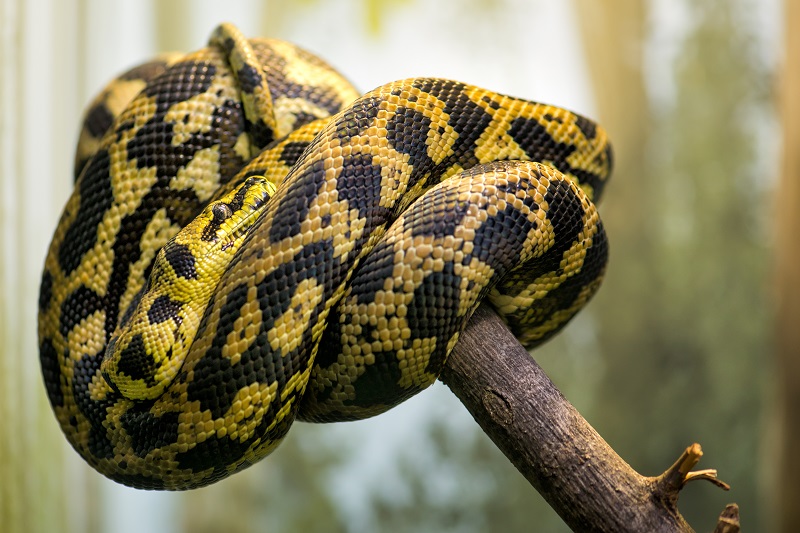
Introduction
Snakes often get a bad reputation for being slithery and secretive creatures. However, what many people don’t realize is that they can also be incredibly warm-hearted and charismatic animals. If you’re considering bringing a snake into your home as a pet, we’ve got all the inside scoop on how to give them the best care possible.
Snake Fact File
- Life Span: Up to 20 years
- Size: Up to 100cm
- Diet: Mice, rats, and quails
- Home: 91cm x 45cm x 60cm tank
Care and Maintenance
Contrary to popular belief, snakes are actually quite low-maintenance pets. They require moderate space and are known for being clean and peaceful. If you’re unsure which snake to choose, the Children’s Python group is a popular choice. Some options within this group include:
- Spotted Python: Known for their even temperament and reaching lengths of up to 100cm, these snakes are often found in North Queensland.
- Children’s Python: These snakes are typically found in Northern Australia and rarely grow to over 1m in length. When exposed to direct sunlight, they can display a rainbow sheen.
- Stimson’s Python: Found in Western Australia, these snakes can grow up to 102cm. They are known for their bright red blotches and are considered the most attractive snake within their group.
Caring for a snake is easier than you might think. As long as you provide them with a proper diet, a heat-regulated enclosure, and something to coil around, your snake will feel right at home. It’s important to note that snakes may go into brumation, a hibernation-like state, during colder weather. This natural process is characterized by decreased activity, increased sleep, and lower appetite.
Licensing
Before bringing a snake into your home, it’s essential to check your local government’s requirements for owning pets. In most cases, you will need to apply for a ‘Companion Animal Keeper Licence’. Each jurisdiction may have specific rules and regulations, so it’s crucial to familiarize yourself with the relevant information. To learn more about reptile licenses in Australia, visit our comprehensive guide.
Setting Up
When setting up your snake’s terrarium, it’s important to consider the size your snake will reach when fully grown. For the substrate, options such as bark mulch, dry leaves, rolled corrugated cardboard, sand, or newspaper are suitable. Additionally, provide branches, rocks, and logs for your snake to explore and coil around.
Unlike many other reptiles, pythons may not require UVB lights if they have access to natural sunlight and reduced shade. Some breeds of pythons tend to bask throughout the year, but it’s always best to consult with a local Petbarn team member to determine if your pet requires additional lighting.
To maintain a suitable temperature for your snake, use a heat map or ceramic heat emitter to ensure a range of 32-35°C in one-third of the enclosure. This temperature gradient allows your snake to cool down when necessary. Your local Petbarn team member can guide you on the appropriate heating options and how to set up a thermostat. It’s essential to clean and disinfect your snake’s terrarium at least once a week to maintain a healthy environment. Always wash your hands before and after handling your snake.
Feeding
As carnivores, snakes have a diet exclusively consisting of meat. Your snake will enjoy a varied diet of mice and birds. Frozen mice and quails are available at your local Petbarn to ensure your pet’s nutritional needs are met.
Don’t be alarmed if your snake occasionally leaves its food uneaten. Snakes have slow metabolisms and can go for months, and sometimes even years, without eating. This is especially true when they go into brumation.
Health Care
Keeping your snake’s habitat clean, providing fresh water, and offering a balanced diet significantly reduces the likelihood of illness or disease. However, it’s important to be aware of potential warning signs indicating that your snake is unwell. Regular check-ups with your local Greencross Vets are essential to ensure your pet’s health and well-being.
Stress is common in domestic pythons due to their unnatural living conditions. If you notice lethargy, jerky movements, or a loss of appetite, it may indicate that your snake is stressed. To minimize stress and lower the risk of disease, create a natural habitat for your snake by providing hiding places, appropriate levels of light, and heat.
Snakes are susceptible to various diseases. Regularly check your snake for swollen jaws, discolored patches, blisters, burns, abscesses, or cloudy eyes. If you notice any symptoms or significant changes, don’t hesitate to reach out to your local Greencross Vets for professional advice and treatment.
Pet Safety Tips
Snakes can exhibit peculiar behaviors due to stress, such as coiling up in their water bowl and refusing to move when introduced to a new habitat. It’s okay to leave them be for a week, but after that, make sure to remove them from the water bowl so they can familiarize themselves with their new home.
Some snakes may have sensitive stomachs, especially when stressed. After a big meal, leave them undisturbed for at least five days. Handling them immediately after eating may cause them to become defensive or regurgitate their food.
Tip: Remember to check your heat lamps every month to ensure they are functioning correctly.
Snake Checklist
You can find all your snake supplies, including frozen mice and rabbits, at Petbarn. Here’s a handy checklist of the essentials:
Housing
- Terrarium
- Substrate
- Heat map or lamp
- Thermostat
- UVB light
- Water dish
- Branches
- Rocks
- Hide-out
Food
- Mice, rats, and quails
Travelling
- Cloth bag
- Ventilated box/container
Shop Now: HOT NEWS DAY
With this care guide, you’ll be well-prepared to provide your pet snake with the love and attention they deserve. Remember to consult with professionals and stay informed about your local regulations to ensure the best possible care for your slithery companion.